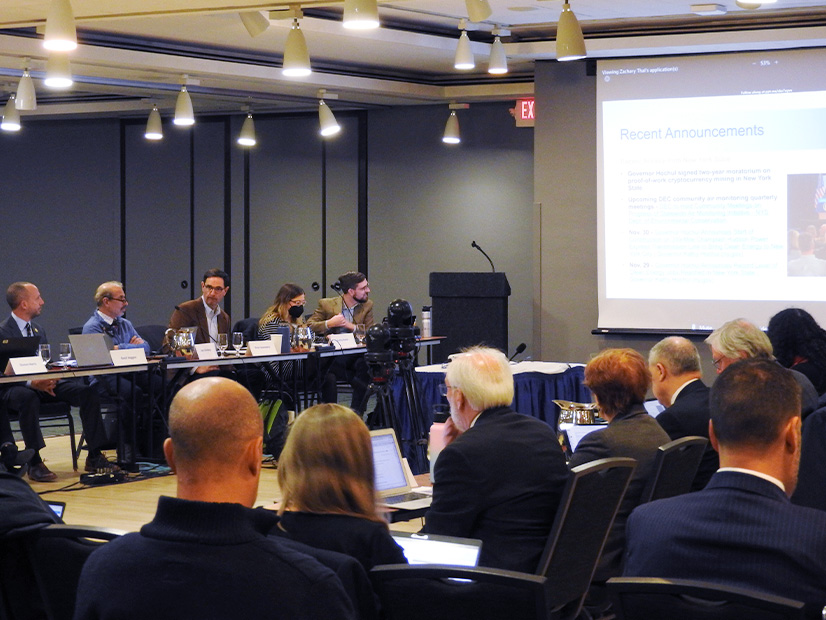ALBANY, N.Y. — The New York Climate Action Council (CAC) met Dec. 5 for its penultimate meeting to discuss the final edits to its scoping plan and debate both labor unions and hydrogen resources.
A presentation given to council members highlighted the edits made to the plan since last month’s meeting, but it also included discussion material stemming from previous CAC debates. (See NY CAC Debates the ‘Nomenclature’ of Natural Gas.)
Hydrogen was the most contentious topic at the meeting, with members upset by the inclusion of “low-carbon-intensity” hydrogen as a sustainable form of hydrogen, alongside green hydrogen.
Robert Howarth, professor at Cornell University, the term is “deceptive” and essentially a way of including blue hydrogen in the plan without actually using that term.
While green hydrogen is produced from water split via renewable-powered electrolysis, with oxygen as its only byproduct, blue hydrogen is produced from splitting methane (CH4), with the emitted carbon captured and sequestered. Opponents of blue hydrogen — among whom Howarth is a leader, having authored a paper against it with Mark Jacobson — argue that the process does not result in net-zero emissions, as the methane used is produced from natural gas.
Howarth argued last week that the inclusion of “low-carbon-intensity” hydrogen would enable the “marketing campaigns of the oil and gas industries” to use the CAC’s plan “to argue for the continued use of fossil hydrogen downstream in New York.” Howarth said the council should be “unambiguous when we send messages to the public, politicians and press.”
Paul Shepson, dean of the College of Marine and Atmospheric Sciences at Stony Brook University, agreed that the concept of hydrogen “was once clear [but] is now quite cloudy,” arguing that the CAC has not investigated blue hydrogen and that “lumping” it with green hydrogen is inappropriate.
Raya Salter, executive director of the Energy Justice Law and Policy Center, said the revisions run “absolutely counter” to the CAC’s work and “look pro-fossil fuel industry.” She said it was “shocking” that “the door had been opened to blue hydrogen.”
Mario Cilento, president of the New York AFL-CIO, expressed support for the inclusion of blue hydrogen because “improving reliability, mitigating against extreme cost increases, avoiding job losses and creating job opportunities” was critical to the success of the scoping plan.
New York Public Service Commission Chair Rory Christian disagreed with members’ characterizations of “low carbon intensity,” saying that the term “blue hydrogen” did not appear anywhere in the current scoping plan and that the language “adequately addresses the concerns raised” while still acknowledging that hydrogen has many potential roles to play in energy generation.
‘Family-sustaining’ Union Jobs
Edits to the “Just Transition” chapter of the plan added language recommending that the jobs created be “good, family-sustaining, union” jobs.
Shepson was confused by the added language, saying it sounded like “part of political slogan.”
Cilento responded that the intention was to emphasize that union jobs tend to have better wages and conditions than non-union jobs. Furthermore, a union workforce would be better positioned to help New York, and “it is easier to sustain a family on union wages than not,” Cilento argued.
Shepson, who said he is supportive of unions, replied that “his non-union [job] has been family-sustaining.” He argued that as currently written, the plan appears to imply that only unions can create worthwhile jobs and that the state’s explicit policy is to only support unions.
Elsenbeck was also confused by the language, saying that, although also supportive of labor unions, it was important to encourage jobs in all their forms and that most of the industry workers he interacts with are not in unions.
The CAC will vote on the final scoping plan on Dec. 19, and council members will also be given an opportunity to share any last statements.
The plan will be formally adopted if it receives a two-thirds supermajority approval vote from the CAC. It would undergo an evaluation assessment at least every four years.


